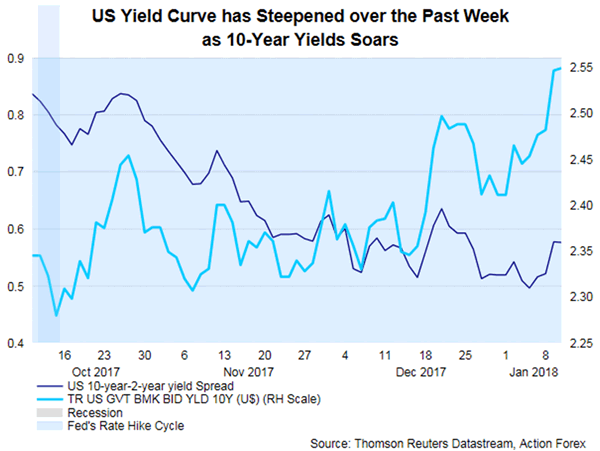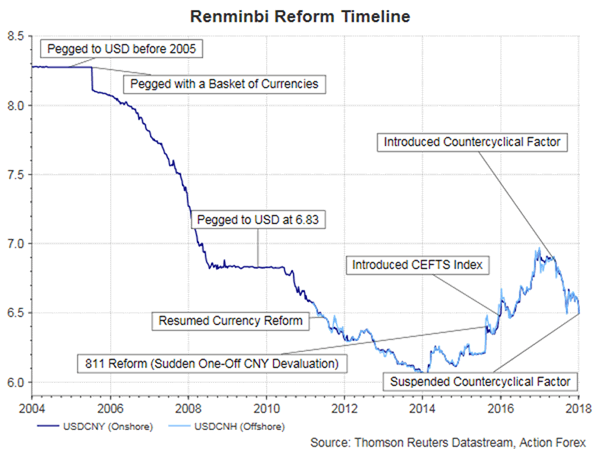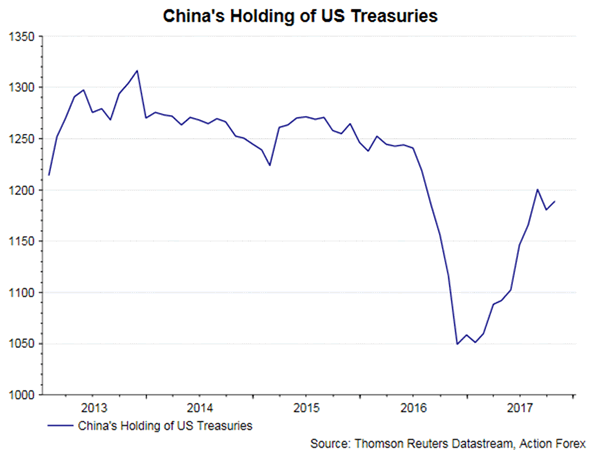Two issues happened in China have roiled the market over the past two days. While the adjustment of renminbi fixing mechanism has resulted in a weaker currency, a news report citing an anonymous Chinese official as recommending to trim or halt purchases of US Treasuries has sent the longer-dated US Treasury (UST) yield higher, thus steepening the UST yield curve. While the former reveals that the Chinese government continues to actually intervene the FX market, putting its commitment to internationalize the currency in question, the latter is merely an act to maintain currency stability and a response as the US-China trade friction once again heats up.

Suspension of the Use of ‘Countercyclical Factor’ in Renminbi Fixing
A new piece on Tuesday suggested that the Chinese government has abruptly suspended the use of ‘countercyclical factor’ in the renminbi fixing mechanism. The instant market reaction was weakness in the currency against US dollar. Recall that back in May 2017, the Chinese government introduced the countercyclical factor as one of the determinants, together with the previous day’s close price of USDCNY and USD movement overnight against the CFETS basket, of the daily renminbi fixing rate. The government explained that use of the ‘countercyclical factor’ was to curb volatility. It is not coincidental that a new ingredient was added during the time when renminbi was staying at the lowest level in 9 years. Indeed, the ‘countercyclical factor’ is just another tool (besides stringent capital control and selling of FX reserve) for the authority to contain renminbi’s depreciation.
Goldman Sachs’ analysis revealed that a negative correlation of the ‘countercyclical factor’ and the previous intra-day price change. Moreover, the factor displayed ‘asymmetric response’ to the exchange rate: the countercyclical factor’s offsetting reaction was bigger following renminbi depreciation in the previous day than following renminbi appreciation. This evidenced that the authority favored stronger renminbi at during the period. Removal of the ‘countercyclical factor’ in the fixing mechanism might signal that the government is not in favor of renminbi appreciation from the current level. Similar to other currencies, USD’s weakness over the past weeks has lifted renminibi, sending the CNYUSD pair to the highest level since September 2017 on January 8. Removal of the ‘countercyclical factor’ suggests that renminbi movement would be more market-determined. However, it is the government’s frequent and unpredictable change in its pricing mechanism that makes it difficult for renminbi to gain the status of a global currency

China to Trim Purchases of US Treasuries
Another news report cited a senior Chinese official recommending to lower or stop purchases of US government bonds. This had sent 10-year yields to a 10-month high of 2.597% at one point before pullback. Undeniably, China is the biggest foreign creditor of US Treasury with a holding of US$ 1.19 trillion as of October 2017. However, China’s calculus in terms of US Treasury purchases is on trade and currency stability. The chart below shows that China had been trimming US Treasury holding in 2016 during the time of massive selloff of renminibi It has resume buying 2017 but the pace accelerated in the mid-year as renminibi movement stabilized.














